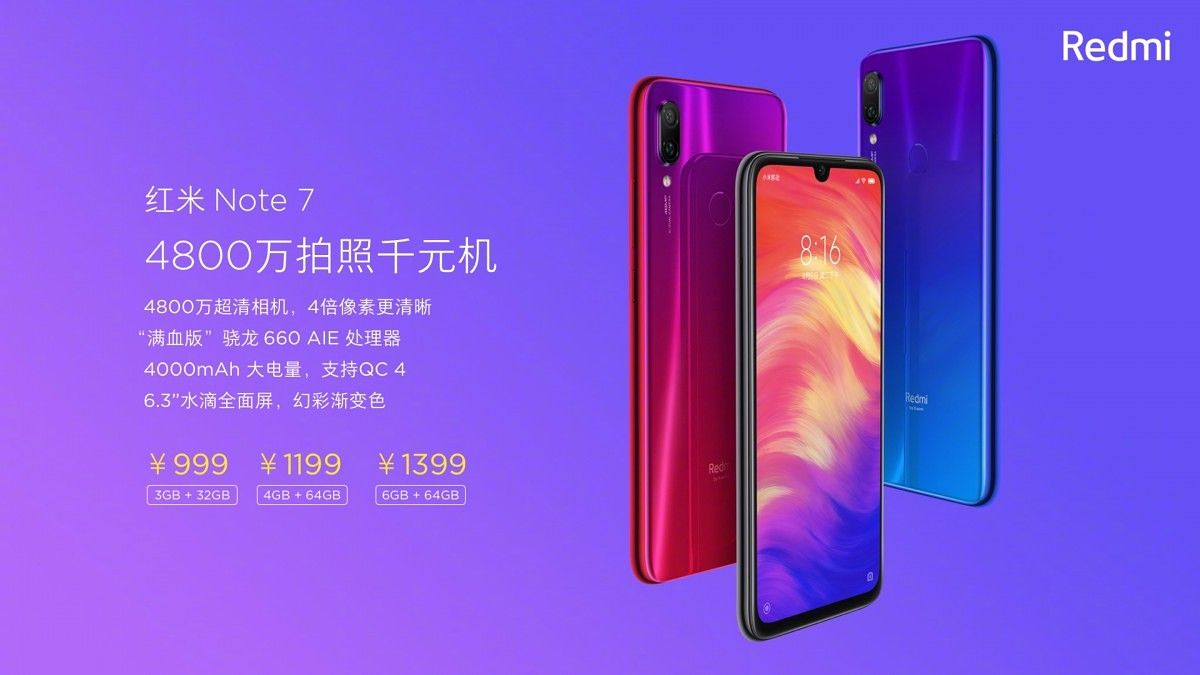The Xiaomi Redmi Note 5 Pro was one of 2018's best-selling lower mid-range phones. It went on to face contenders from device makers such as Asus, Honor, Realme, HMD Global, and Motorola, but even until November, it was one of the best ~$200 phones to buy. In September, the phone was succeeded by the Xiaomi Redmi Note 6 Pro, which was an incremental update in terms of specifications. This meant that the Redmi Note series risked falling behind competitors such as the Asus ZenFone Max Pro M2. Xiaomi's answer to this, it seems, has been to expedite its release cycle. Last week, the company spun off its Redmi series as a separate brand focused on budget devices, after having launched the POCO sub-brand last year. Since December, Xiaomi has also been teasing the launch of a new phone with a 48MP camera. That phone---the Redmi Note 7---has now been made official in China.
The Redmi Note 7's announcement comes less than four months after the Redmi Note 6 Pro's initial announcement in September. In India, the Redmi Note 6 Pro went on sale in late November, which means that the phone has been succeeded incredibly quickly. It's not just another incremental update, either. The Redmi Note 7 comes with a brand new design that rivals the Honor 8X. It's powered by a more capable SoC (the Snapdragon 660). It has a waterdrop notch. The phone's USP is the brand-new 48MP primary rear camera. Finally, the Redmi Note 7 switches from the deprecated microUSB port to the modern USB Type-C port with Quick Charge 4 support. There is a lot more to get into, so let's start with the specifications list.
Redmi Note 7 - Specifications at a glance
|
Category |
Redmi Note 7 |
|---|---|
|
Dimensions and weight |
159.2 x 75.2 x 8.1 mm, 186g |
|
Software |
MIUI 10 on top of Android 9 Pie |
|
Display |
|
|
System-on-chip |
|
|
RAM and storage |
3GB/4GB/6GB RAM with 32GB/64GB storage |
|
Battery |
|
|
Rear camera |
|
|
Front camera |
13MP with f/2.0 aperture |
|
Ports |
USB Type-C port, dual nano-SIM slots, 3.5mm headphone jack |
|
Connectivity |
|
|
Colors |
Twilight Gold, Fantasy Blue, Bright Black |
The Redmi Note 7's design is a drastic departure from previous Redmi Note phones. It has a gradient finish on the back, reminiscent of the Honor 8X. This also means that the phone switches away from a metal back. (It's unclear for now whether the back is made of glass or glossy plastic, but it is probably glass.) In terms of aesthetics, the Redmi Note 7 brings a fresh new look to Xiaomi's best-selling (and market defining) series.
While the Redmi Note 6 Pro had a fairly wide display notch, the Redmi Note 6 Pro moves to a waterdrop notch. This means that fans hoping to see punch-hole displays on Redmi phones will have to wait another generation. Nothing comes for free, however. The Redmi Note 7 drops the Redmi Note 6 Pro's dual front camera arrangement for a single front camera, and the specifications of the primary front camera have also been changed from 20MP to 13MP. Xiaomi is also promoting the thin 1.95mm side bezels of the Redmi Note 7.
Camera
The Redmi Note 7 has a 48MP primary camera. It does not use the Sony IMX586 sensor, though, instead opting to go with a ISOCELL Bright Samsung GM1 sensor, which was announced in October. The phone comes with a Super Night Mode, which was first introduced in the Xiaomi Mi Mix 3. It has a Quad Bayer filter, similar to the Huawei P20 Pro. In daylight, it can use super resolution techniques to output 48MP photos with 0.8μm pixels. In low light, the phone uses 4-in-1 pixel binning to simulate 1.6μm pixels and take photos with an effective resolution of 12MP. It has a f/1.8 aperture and a relatively huge 1/2" sensor size (for smartphone cameras). The primary camera is coupled with a 5MP depth sensor with an f/2.4 aperture.
On the face of it, the rear camera setup looks promising, especially for a phone in the lower mid-range price bracket. The front camera is less impressive on paper. The resolution has been downgraded to 13MP, and the Redmi Note 6 Pro's depth sensor doesn't make it to the Redmi Note 7.
Pricing and availability
In China, the Redmi Note 7's pricing starts off at CNY 999 ($147) for the 3GB RAM/32GB storage variant. The 4GB RAM/64GB storage variant costs CNY 1,199 ($177), while the 6GB RAM/64GB storage variant goes for CNY 1,399 ($206). The phone is now available for pre-ordering, and shipments are scheduled for January 15.
For now, Xiaomi hasn't given any details regarding international availability of the Redmi Note 7. On account of the immense popularity of the Redmi Note series, however, it's fair to expect an international launch soon. On the face of it, the Redmi Note 7 seems to be the new benchmark phone in the lower mid-range price segment.

